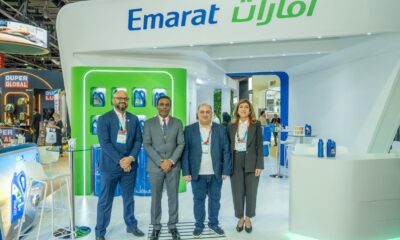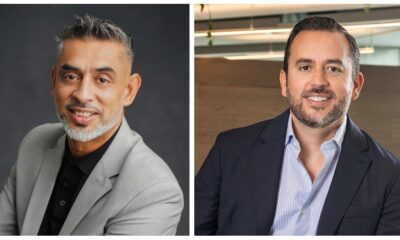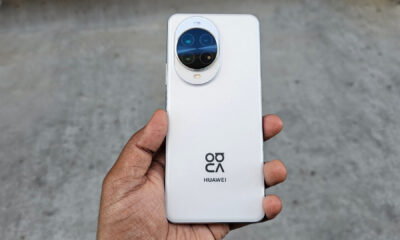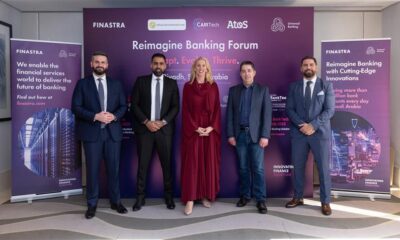Tech Features
Techniques Windows & Saada: Pioneering Automation Excellence in the Middle East

Setting New Standards in Automation Systems
In the rapidly evolving landscape of automation systems, Techniques Windows & Saada Company has established itself as a formidable leader in Saudi Arabia and beyond. Founded with a vision to revolutionize automation services, the company has grown from its headquarters in Riyadh to establish a significant presence across Saudi Arabia and Egypt, with ambitious plans for international expansion.

The company’s success story is built on a foundation of technical expertise, innovative solutions, and an unwavering commitment to client satisfaction. “The first way to success is learning,” emphasizes CEO Mohammed Saada. “A person creates his value according to the information he has. We at Nawafedh Tech and Saada Company, one of our most important successes is the positive impact in teaching the market the basics of products and selling points, as well as successful technical support and ways to build successful relationships in business. We confirm that we will continue with this policy forever because it is the most successful and carries within it social ethics before business ethics.”
This educational philosophy has become a defining characteristic of the company’s business model, setting it apart in an increasingly competitive market. The organization’s commitment to fostering understanding and building lasting relationships has created a unique ecosystem where business ethics and social responsibility converge seamlessly.
Strategic Partnership with Seagate
A significant milestone in the company’s journey has been its strategic partnership with Seagate, a collaboration that has yielded remarkable results for both organizations. This alliance has strengthened Techniques Windows & Saada’s position in distribution channels and enhanced its project delivery capabilities. The partnership has proven particularly valuable in building customer trust, with Seagate’s reputation for quality, comprehensive warranty coverage, and competitive features complementing Techniques Windows & Saada’s service excellence.
Technical Excellence and Service Quality
The company’s technical team comprises highly skilled professionals who specialize in creating customized automation solutions tailored to specific client requirements. This expertise, combined with adherence to stringent quality standards and exceptional after-sales service, has earned Techniques Windows & Saada a reputation for reliability and excellence.
In an industry where competitive pricing often comes at the expense of quality, Techniques Windows & Saada has successfully maintained a balance, offering premium services at reasonable rates. This approach has helped the company forge strong partnerships with numerous organizations, both within Saudi Arabia and internationally.
Shaping the Future of Automation
Looking ahead, Techniques Windows & Saada is positioned for significant growth, with plans to expand its geographical footprint through new overseas branches. The company continues to invest in emerging technologies and skill development, ensuring its team stays ahead of industry trends and innovations.
The success of Techniques Windows & Saada reflects a deeper understanding of market dynamics and customer needs. By combining technical excellence with a strong educational component, the company has created a sustainable business model that benefits all stakeholders. As automation technology continues to evolve, Techniques Windows & Saada remains committed to its founding principles of quality, innovation, and customer satisfaction, while exploring new opportunities to expand its influence in the global automation sector.
This commitment to excellence, coupled with strategic partnerships like the one with Seagate, positions Techniques Windows & Saada as a key player in shaping the future of automation systems in the Middle East and beyond. As the company continues to grow and evolve, its focus remains firmly on delivering value through innovation, education, and exceptional service.
Tech Features
THE RISE OF THE AUTONOMOUS ECONOMY: A 2025 RETROSPECTIVE FROM THE MIDDLE EAST
Kayvan Karim, Assistant Professor at School of Mathematical and Computer Sciences, Heriot-Watt University Dubai
The year 2025 will likely be remembered as the moment the global economy stopped simply automating tasks and started handing over the keys to autonomous agents. For decades, the promise of automation was simple: machines doing repetitive work faster than humans. But the last twelve months have ushered in a fundamental paradigm shift. We have moved from the era of static scripts to the age of “Agentic AI”, systems that don’t just follow orders but perceive, reason, and act to achieve complex goals.
In their 2025 Technology Trends report, Accenture’s analysts have termed the explosion of these capabilities as “The Binary Big Bang”. As generative AI becomes central to enterprise technology, the cost of development has plummeted, leading to a proliferation of new systems where digital agents act autonomously. These systems have given rise to Agentic AI, which acts as a proactive partner rather than a passive interface. These agents are now capable of “Superagency,” a collaboration architecture that orchestrates multi-agent systems to handle complex workflows that require specialised knowledge across different domains.
This shift is nowhere more palpable than in the Middle East. From the giga-projects of Saudi Arabia to the smart logistics hubs of Dubai, the region is leveraging this technological inflection point to decouple its economic future from hydrocarbons and rebuild it on a foundation of silicon and code.
The Economics of Intelligence
The catalyst for this revolution is a dramatic collapse in the cost of cognitive labour. When examining the economics of intelligence, Stanford University reported in its 2025 AI Index Report that the catalyst for this explosion in autonomy is the radical democratisation of computing power. Between late 2022 and late 2024, the inference cost for a system performing at the level of GPT-3.5 dropped over 280-fold. This trend accelerated through 2025, with hardware costs declining by approximately 30% annually and energy efficiency improving by 40% each year.
These economic shifts have lowered the barriers to entry, moving advanced AI from the realm of massive research labs to the operational budgets of mid-sized enterprises. As Menlo Ventures noted in their mid-year update, enterprise spending on model APIs more than doubled to $8.4 billion in the first half of 2025 alone, signalling a decisive shift from experimental “training” budgets to production-grade “inference” budgets.
The Middle East’s Sovereign Pivot
In the Gulf Cooperation Council (GCC), this technological wave is being ridden with strategic intent. The region is not content to merely import Western or Eastern models; it is building its own “Sovereign AI.”
In the UAE, the Technology Innovation Institute (TII) has continued to push boundaries with its Falcon series. As highlighted by ITU in 2025, the Falcon LLM has evolved into a multi-modal framework capable of processing vision and audio, enabling it to interpret complex documents and charts locally without data leaving the country. Similarly, G42’s Inception has solidified Jais’s position as the world’s premier Arabic-centric model. By integrating Jais into the Microsoft Azure Model Catalogue, they have provided generative AI access to over 400 million Arabic speakers, ensuring that the nuances of the region’s language and culture are preserved in the digital age.
Saudi Arabia has matched this ambition with the launch of Humain, a PIF-backed AI champion. According to Reuters reports from late 2025, Humain is not only building massive data centre capacity but is also developing a voice-first operating system designed to replace traditional icon-based interfaces. This aligns with the Kingdom’s broader Vision 2030 goals, where AI is expected to contribute over $135 billion to the economy.
From Automation to Autonomy in Industry
The distinction between “automation” (following rules) and “autonomy” (making decisions) is best illustrated in the region’s critical infrastructure.
In the energy sector, Saudi Aramco and Yokogawa achieved a historic milestone at the Fadhili Gas Plant. As reported by Oilfield Technology, they successfully deployed autonomous control AI agents that utilise reinforcement learning to optimise the Acid Gas Removal unit actively. Unlike traditional systems, these agents adapt to changing environmental conditions without human intervention, reducing chemical and steam consumption by up to 15%.
Similarly, ADNOC partnered with G42 and Microsoft to launch “EnergyAI.” This agentic system automates complex tasks such as seismic analysis and geological modelling, compressing workflows that used to take months into mere days.
In logistics, the shift is physical. DP World has revolutionised container handling at Jebel Ali with the BoxBay system. As described by Marine Insight, this high-bay storage technology stacks containers up to 11 tiers high in a steel rack, allowing fully automated cranes to access any container without having to reshuffle others. This change increases terminal capacity by 300% and creates a safer, more efficient operating environment.
The GenAI Divide: Enterprises vs. SMEs
While giants like Aramco and DP World forge ahead, the picture for Small and Medium Enterprises (SMEs) is more complex. Project NANDA’s 2025 research highlights a “GenAI Divide,” revealing that while 95% of organisations are investing in AI, only 5% are extracting significant value.
For SMEs, the barriers are talent and infrastructure. However, the rise of Low-Code/No-Code platforms is providing a bridge. As reported by Gulf News, Zoho has seen 50% growth in the region, driven by businesses modernising legacy systems without the need for expensive engineering teams.
To further support this sector, the Saudi SME Bank launched Phase II of its Agency Model in 2025. By partnering with crowdfunding platforms like Manafa and Lendo, they have allocated SAR 240 million specifically to finance SME growth and digital transformation.
The Future of Work: A Divergent Path
The impact on the job market is profound. The World Economic Forum’s “Future of Jobs 2025” report predicts a divergent effect: while routine roles in administration and manual labour are declining, demand for AI and big data specialists is surging.
In the GCC, this dynamic intersects with nationalisation agendas. Governments are using AI to solve the skills mismatch. The Massar Al Ghurair platform, launched in the UAE in 2025, uses AI algorithms to match Emirati youth with career paths and upskilling opportunities. By automating career counselling and recruitment, the region aims to replace low-skilled expatriate labour with high-skilled local talent.
Looking Ahead to 2026
As we look toward 2026, the focus will shift from adoption to governance and integration. Gartner forecasts that IT spending in the MENA region will reach $169 billion in 2026, an 8.9% increase mainly driven by AI infrastructure.
We can expect the realisation of “Cognitive Cities.” In Saudi Arabia, NEOM is moving from earthworks to deploying a cognitive operating system that predicts resident needs. Meanwhile, Dubai’s Cashless Strategy aims to have 90% of all transactions be digital by 2026, creating a data-rich environment for further autonomous innovation.
The year 2025 was the year the machines started to think. The year 2026 will be the year we learn to live and work alongside them.
Tech Features
Why 92% of People Never Achieve Their Dreams — And How AI Can Help Change That

Artificial intelligence is emerging as an unexpected ally in one of humanity’s oldest struggles: turning dreams into reality. After years spent working with thousands of entrepreneurs, corporates, startups, and students, individuals standing at every possible crossroad of ambition, uncertainty, and reinvention, a pattern has surfaced with striking consistency. Most people are not held back by the size of their dreams. They are held back by the psychological distance between who they are today and who they hope to become. AI, with its growing ability to illuminate patterns, reduce overwhelm, and bring the future self-closer, is beginning to reshape this fundamental human challenge.
Across conversations in boardrooms, incubators, classrooms and quiet mentoring sessions, this distance appears in countless forms. A bright student maps out a compelling future but loses momentum within days. A corporate leader imagines a more meaningful life but finds the path too overwhelming. An entrepreneur gains clarity but cannot sustain action long enough to see results. Ambition is abundant. Follow through remains elusive.

Founder and CEO, Unlimits
The research behind this is both revealing and deeply human. Studies from UCLA, Stanford and other behavioral laboratories demonstrate that individuals act more consistently when they feel emotionally connected to their future self. Yet most people experience that version of themselves not as an extension of who they are, but as a stranger, someone they hope to meet one day but rarely feel responsible for today. As behavioral economists often explain, we don’t make sacrifices for strangers. And so the dream, however sincere, slips into the long grass of “someday. “This explains why nearly 92% of people fail to achieve the goals they set each year. Dreams are not the problem. The disconnect is.
People blame discipline or lack of motivation, but the truth is simpler. The human mind is wired to favor the familiar. The comfort zone, often demonised, is really just biology trying to protect us from the uncertain. Yet underneath those instincts lies an innate desire for growth, a longing to expand, to evolve, to become the person one senses they could be.
For years, the missing ingredient was structural support. A vision, no matter how inspiring, cannot survive without a scaffold. People needed a way to break overwhelming goals into manageable steps. They needed reflection, accountability, and a rhythm that kept intention alive long enough for identity to shift. Most never had access to that level of support. This is where AI has quietly begun altering the landscape of human development.
In recent global surveys, nearly 40% of people expressed willingness to use AI for emotional clarity, self-reflection, and goal-setting. The World Health Organization launched pilot programmes using conversational AI to support mental wellness in regions with limited resources. Early research across Stanford and MIT shows that AI-assisted coaching improves consistency, habit adherence, and long-term follow through. The reason is not complicated. AI offers something the human mind struggles to maintain: clarity without fatigue.
It notices emotional cycles, the midweek dip, the avoidance that follows stressful meetings, the patterns that appear but go unrecognised. It highlights the small behaviours that shape larger outcomes. It breaks down a daunting dream into a sequence of steps simple enough to act on. And it does this with presence, available at the precise moment a person needs support, rather than during a weekly appointment.
What emerges is a new kind of ecosystem. The integration of AI into mobile technology has made tools for self-improvement astonishingly accessible. Personalised guidance, once available only to those who could afford coaching or therapy, now exists in people’s pockets. It is immediate, responsive, and deeply personal. This accessibility represents the democratisation of personal transformation, a shift as meaningful as AI’s impact on coding, business building, or creative work.
Yet AI alone is not the solution. Its impact is most profound when it works alongside the wisdom of coaching, the emotional insight of reflection, and a clear vision of one’s future self. When these elements converge, something remarkable happens: people stop dreaming abstractly and begin acting concretely. They replace “someday” with “today.” The future stops feeling distant. Action becomes less of a battle and more of a natural extension of identity.
This convergence of psychology, coaching and intelligent technology represents one of the most significant shifts in human development in decades. It finally offers a way to bridge the space between intention and behaviour, a gap that has defeated generations of dreamers.
If most people never achieve their dreams, it is not because those dreams are unreachable. It is because the scaffolding required to turn dreams into daily behaviour has been missing.
But that is beginning to change.
With the right structure, the right clarity, and the right support, both human and technological, more people can finally walk into the future they have imagined for far too long. The promise of AI is not that it will change who we are, but that it may help us become who we were always capable of being.
Tech Features
DIGITAL INFRASTRUCTURE OF THE FUTURE: GOVERNMENTS AND CORPORATIONS DOUBLE DOWN ON CLOUD, AI & CONNECTIVITY
By Dr. Fadi Alhaddadin, Assistant Professor at School of Mathematical and Computer Sciences, Heriot-Watt University Dubai
In 2025, governments and enterprises globally made unprecedented investments in cloud data centres, artificial intelligence, and connectivity to drive growth and secure sovereignty, manage latency, and build the foundation for a new era of digital infrastructure.
In a decisive shift toward future-ready infrastructure, both governments and the private sector have invested billions into expanding cloud capacity, scaling AI, and strengthening connectivity. This year’s investments reflect a strategic convergence: countries want control, companies want capacity, and both want the low-latency, high-power compute necessary for emerging AI-driven services. According to Microsoft’s official announcement, the company committed USD 15.2 billion to expand its AI and cloud infrastructure in the United Arab Emirates, marking one of the largest digital investments in the region. Such investment highlights how global tech giants are increasingly treating the Middle East as a priority market for sovereign-like cloud architecture.
The Sovereign Cloud Race
In parallel, governments are not just buying cloud, they’re building sovereign clouds. A sovereign cloud is a cloud computing infrastructure physically located within a country’s borders, subject to its jurisdiction, and often tailored for regulated or sensitive workloads. This type of cloud helps governments and regulated industries meet data residency, security, and compliance demands. Many governments are negotiating contracts or building partnerships with hyperscale providers to deploy sovereign cloud; Microsoft has expanded its sovereign-cloud services for government agencies. However, it is worth mentioning that building sovereign clouds is expensive, energy-intensive, and may lead to vendor lock-in if not managed with competition and resilience in mind.
These are cloud platforms designed to reside entirely within national borders, under local jurisdiction, and subject to domestic regulation. The UK announced a major national AI and cloud package in 2025 that couples public procurement reform, research grants, and cloud infrastructure deals, aligning enterprise modernization with national strategic priorities. Companies like Microsoft and Palantir have responded by tailoring their offerings. Microsoft expanded its sovereign cloud portfolio, providing government agencies with specialized contracts and pricing, while Palantir has embedded its analytics platforms into secure, regulation-aware cloud environments for defence and intelligence users.
As sovereign needs grow, hyperscale cloud providers are racing to build data centres in strategic markets. Google stated in its public briefing that it will invest €5.5 billion in Germany to expand data-centre capacity and strengthen the country’s AI and cloud infrastructure. This emphasises its commitment to AI infrastructure in Europe. At the same time, Oracle confirmed through its company announcement that it will invest USD 5 billion in the United Kingdom to expand its cloud infrastructure and support the country’s growing demand for sovereign and secure cloud services.
AWS announced that it has launched a new “Mexico (Central)” region as part of a long-term plan that includes more than USD 5 billion of investment, and that it is also building a Taipei region with three availability zones to serve customers in Taiwan locally and reduce latency. The provider’s expansion into markets like Mexico and Taiwan illustrates how providers are balancing commercial demand with sovereign or regulated-sector requirements.
The future of digital infrastructure is not only vertical but horizontal: low-latency connectivity and edge computing are just as important as data centres. Dubai, for instance, announced a major hyperscale data-centre project in conjunction with its AI ambitions, highlighting how smart cities are weaving together cloud, 5G, and datacentre capacity. Telecom operators globally also stepped-up investments in 5G deployment, edge compute nodes, and fibre networks which is critical for AI workloads that require real-time responsiveness, such as industrial automation or smart-city services.
Infrastructure alone is not enough. This year, governments also heavily invested in capacity-building: AI skilling programs, public sector procurement reform, and governance frameworks became part of the digital infrastructure agenda. According to the Stanford HAI AI Index 2025, regulatory activity surged globally, while investments in AI research and public-sector readiness spiked. Likewise, OECD guidance such as Governing with Artificial Intelligence emphasised that infrastructure must be paired with governance, procurement rules, and data-management policies to ensure trust and long-term value.
What This Means for Business and Citizens
These investments yield several major impacts:
- For regulated sectors such as government, finance, and defence, more local cloud capacity means access to advanced compute without compromising on compliance or data residency.
- For AI-first products, building infrastructure close to end users cuts latency and cost, making real-time and mission-critical applications more feasible.
- For competition, the concentration of compute in a few hyperscalers raises pressing questions about vendor lock-in, resilience, and market power.
- For national sovereignty, governments are not just consumers but active shapers of cloud infrastructure through sovereign cloud projects and public-private partnerships.
One emerging model: states acting both as customers (buying cloud) and guardians (regulating, building, and participating in infrastructure). If done right, this could deliver both cutting-edge technology and safeguard public interests. If misaligned, it risks reinforcing dependence on a small number of foreign providers.
Risks and Tensions: Who Controls the Cloud?
The scale of these infrastructure projects brings serious challenges. Building datacentres at this scale stresses energy grids and raises sustainability concerns. Meanwhile, smaller countries worry about over-reliance on foreign cloud providers and whether they’ll truly get local control. Switzerland’s example illustrates these trade-offs well: Microsoft pledged substantial investment there for AI and cloud capacity while emphasizing data-locality for sensitive sectors which is a delicate balance between growth and sovereignty.
Toward a Resilient, Equitable Digital Future
The pattern that emerged this year is clear: infrastructure, policy, and people must all evolve together. Hyperscalers are building, governments are investing, and both are increasingly thinking in terms of long-term digital sovereignty as well as economic opportunity.
If countries can align public policy with private investment especially on cloud, AI, and connectivity, they could host world-class AI platforms while preserving public governance. But the risk is real: if power remains concentrated, the dividends of this digital transformation may not be as widely shared.
-

 Tech News1 year ago
Tech News1 year agoDenodo Bolsters Executive Team by Hiring Christophe Culine as its Chief Revenue Officer
-

 VAR8 months ago
VAR8 months agoMicrosoft Launches New Surface Copilot+ PCs for Business
-

 Tech Interviews2 years ago
Tech Interviews2 years agoNavigating the Cybersecurity Landscape in Hybrid Work Environments
-

 Tech News5 months ago
Tech News5 months agoNothing Launches flagship Nothing Phone (3) and Headphone (1) in theme with the Iconic Museum of the Future in Dubai
-

 Tech News2 years ago
Tech News2 years agoBrighton College Abu Dhabi and Brighton College Al Ain Donate 954 IT Devices in Support of ‘Donate Your Own Device’ Campaign
-

 Editorial1 year ago
Editorial1 year agoCelebrating UAE National Day: A Legacy of Leadership and Technological Innovation
-

 VAR1 year ago
VAR1 year agoSamsung Galaxy Z Fold6 vs Google Pixel 9 Pro Fold: Clash Of The Folding Phenoms
-

 Cover Story9 months ago
Cover Story9 months agoUnifonic Leading the Future of AI-Driven Customer Engagement























